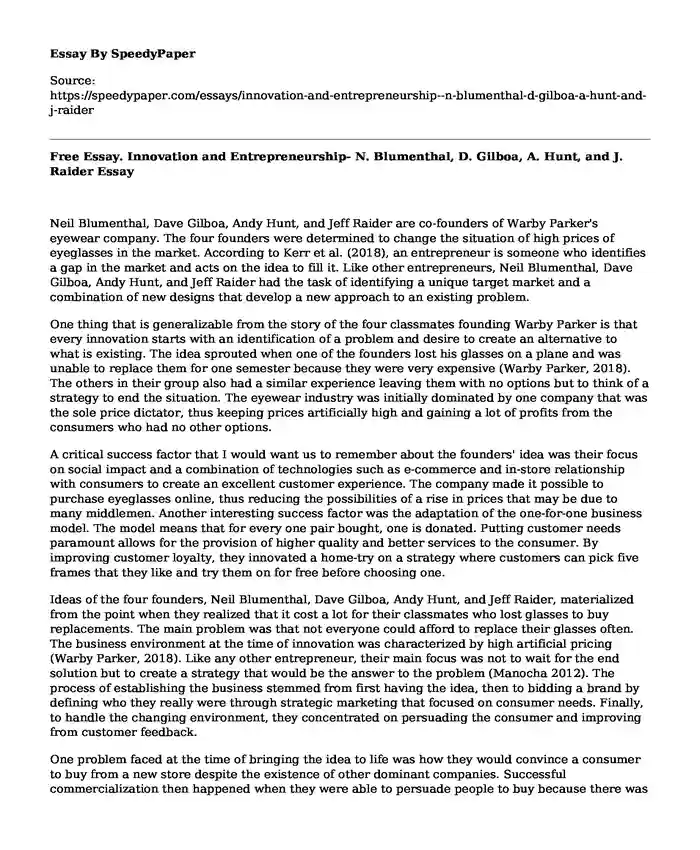
| Type of paper: | Research paper |
| Categories: | Problem solving Strategic management Leadership development Leadership style |
| Pages: | 3 |
| Wordcount: | 748 words |
Neil Blumenthal, Dave Gilboa, Andy Hunt, and Jeff Raider are co-founders of Warby Parker's eyewear company. The four founders were determined to change the situation of high prices of eyeglasses in the market. According to Kerr et al. (2018), an entrepreneur is someone who identifies a gap in the market and acts on the idea to fill it. Like other entrepreneurs, Neil Blumenthal, Dave Gilboa, Andy Hunt, and Jeff Raider had the task of identifying a unique target market and a combination of new designs that develop a new approach to an existing problem.
One thing that is generalizable from the story of the four classmates founding Warby Parker is that every innovation starts with an identification of a problem and desire to create an alternative to what is existing. The idea sprouted when one of the founders lost his glasses on a plane and was unable to replace them for one semester because they were very expensive (Warby Parker, 2018). The others in their group also had a similar experience leaving them with no options but to think of a strategy to end the situation. The eyewear industry was initially dominated by one company that was the sole price dictator, thus keeping prices artificially high and gaining a lot of profits from the consumers who had no other options.
A critical success factor that I would want us to remember about the founders' idea was their focus on social impact and a combination of technologies such as e-commerce and in-store relationship with consumers to create an excellent customer experience. The company made it possible to purchase eyeglasses online, thus reducing the possibilities of a rise in prices that may be due to many middlemen. Another interesting success factor was the adaptation of the one-for-one business model. The model means that for every one pair bought, one is donated. Putting customer needs paramount allows for the provision of higher quality and better services to the consumer. By improving customer loyalty, they innovated a home-try on a strategy where customers can pick five frames that they like and try them on for free before choosing one.
Ideas of the four founders, Neil Blumenthal, Dave Gilboa, Andy Hunt, and Jeff Raider, materialized from the point when they realized that it cost a lot for their classmates who lost glasses to buy replacements. The main problem was that not everyone could afford to replace their glasses often. The business environment at the time of innovation was characterized by high artificial pricing (Warby Parker, 2018). Like any other entrepreneur, their main focus was not to wait for the end solution but to create a strategy that would be the answer to the problem (Manocha 2012). The process of establishing the business stemmed from first having the idea, then to bidding a brand by defining who they really were through strategic marketing that focused on consumer needs. Finally, to handle the changing environment, they concentrated on persuading the consumer and improving from customer feedback.
One problem faced at the time of bringing the idea to life was how they would convince a consumer to buy from a new store despite the existence of other dominant companies. Successful commercialization then happened when they were able to persuade people to buy because there was a promise for excellent customer care. Khadka and Maharjan (2017) delineate that customer loyalty is highly driven by customer satisfaction. The company chose to put the needs of the consumer paramount before price.
In conclusion, Neil Blumenthal, Dave Gilboa, Andy Hunt, and Jeff Raider began their idea by creating a vertically integrated company that aimed at bypassing retailers and middlemen. The purpose of bypassing was to transfer direct costs to the consumer and help them save money. In the contemporary entrepreneurial world, businesses have evolved to place consumer needs first as their primary interest rather than profits and rewards.
References
Kerr, S. P., Kerr, W. R., & Xu, T. (2018). Personality traits of entrepreneurs: A review of recent literature. Foundations and Trends in Entrepreneurship, 14(3), 279-356. Retrieved from https://www.hbs.edu/faculty/publication%20files/18-047_b0074a64-5428-479b-8c83-16f2a0e97eb6.pdf
Khadka, K., & Maharjan, S. (2017). Customer satisfaction and customer loyalty: Case trivsel stadtjanster (trivsel siivouspalvelut). Retrieved from https://core.ac.uk/download/pdf/161421179.pdf
Manocha, S. (2012). Innovation And Entrepreneurship in Today's Scenario. International Journal of Marketing, Financial Services & Management Research, 1(8), 196-205. Retrieved from http://indianresearchjournals.com/pdf/IJMFSMR/2012/August/15.pdf
Warby Parker. (2018). Impact Report, 2018. https://www.warbyparker.com/assets/img/impact-report/report-2018.pdf
Cite this page
Free Essay. Innovation and Entrepreneurship- N. Blumenthal, D. Gilboa, A. Hunt, and J. Raider. (2023, Apr 05). Retrieved from https://speedypaper.net/essays/innovation-and-entrepreneurship--n-blumenthal-d-gilboa-a-hunt-and-j-raider
Request Removal
If you are the original author of this essay and no longer wish to have it published on the SpeedyPaper website, please click below to request its removal:
- Should Electronics Be Allowed in School. Free Essay Example.
- Personal Essay Sample About Connections
- Essay Sample Analyzing the Failure of the REACH Project
- No Name Woman and The Yellow Wallpaper, Literary Essay Sample
- Free Essay Sample on How to Deliver a Speech Without Losing Interest in the Audience
- Free Essay Sample: Keys to Effective Management
- Youth in Criminal Justice
Popular categories




